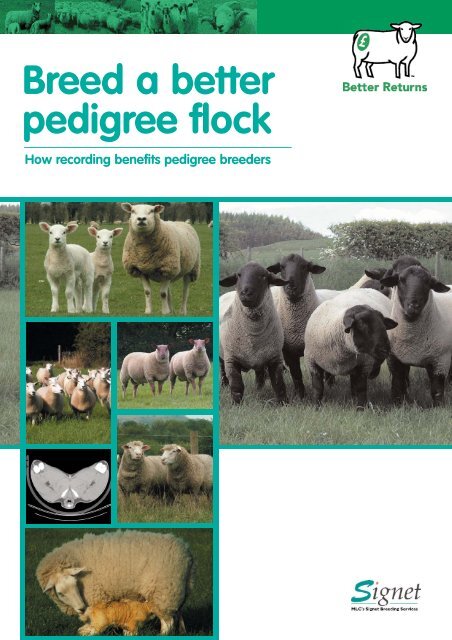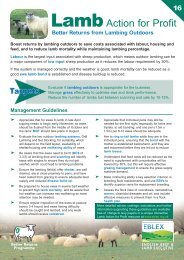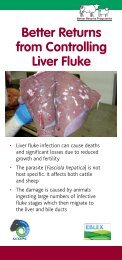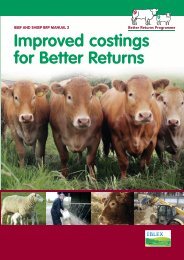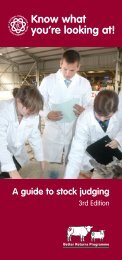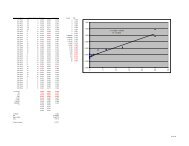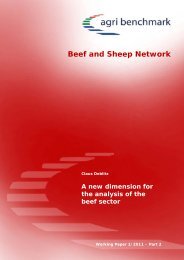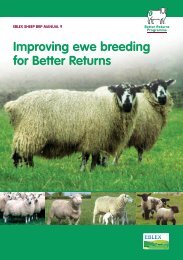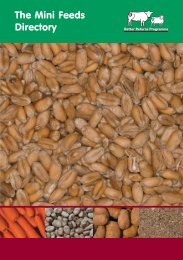Booklet - Breed a Better Pedigree Flock - Eblex
Booklet - Breed a Better Pedigree Flock - Eblex
Booklet - Breed a Better Pedigree Flock - Eblex
Create successful ePaper yourself
Turn your PDF publications into a flip-book with our unique Google optimized e-Paper software.
<strong>Breed</strong> a better<br />
pedigree flock<br />
How recording benefits pedigree breeders
EBLEX <strong>Better</strong> Returns has funded the<br />
writing and publication of this booklet.<br />
While the authors have worked on<br />
the best information available to them,<br />
neither EBLEX, nor the authors shall<br />
in any event be liable for any loss,<br />
damage or injury howsoever suffered<br />
directly or indirectly in relation to the<br />
booklet or the information on which<br />
it is based.<br />
Reference herein to trade names and<br />
proprietary products and services<br />
without stating that they are protected<br />
does not imply that they may be<br />
regarded as unprotected and thus<br />
free for general use. No endorsement<br />
of named products or services is<br />
intended nor any criticism implied<br />
of other alternative but<br />
unnamed products.
<strong>Breed</strong><br />
abetter<br />
pedigree<br />
flock<br />
How recording<br />
benefits pedigree<br />
breeders<br />
Contents<br />
1. Why should I record my flock?<br />
2. Planning your breeding strategy<br />
3. What do I have to do?<br />
4. Estimated <strong>Breed</strong>ing Values<br />
5. <strong>Breed</strong>ing Indexes<br />
Terminal Sire Index<br />
Maternal Index<br />
Longwool Index<br />
Welsh Index<br />
Hill 2 Index<br />
6. Types of evaluation and flock connectedness<br />
7. Measurement services<br />
Ultrasound scanning service<br />
Computed tomography<br />
Gigot muscularity<br />
<strong>Breed</strong>ing for worm resistance<br />
8. Advances in Terminal Sire breeds recording<br />
9. Advances in Hill and Maternal breeds recording<br />
10 Interpreting <strong>Breed</strong>ing reports<br />
11 Making faster progress by harnessing new technologies<br />
12 Further information
3<br />
1. Why should I record my flock?<br />
Performance recording gives pedigree breeders and ram<br />
buyers an objective way to assess the genetic potential<br />
of rams selected for breeding.<br />
Recording adds value to pedigree breeders<br />
As Estimated <strong>Breed</strong>ing Values (EBVs) become more widely<br />
promoted, rams with high EBVs regularly achieve £300-<br />
£400 premiums at ram sales. More importantly, clearance<br />
rates are higher than those for unrecorded flocks.<br />
In an EBLEX survey over 90% of pedigree producers<br />
believed that interest in performance recording had risen in<br />
the past two years. With commercial buyers actively seeking<br />
recorded rams with the right EBVs, it clearly pays to record.<br />
Commercial buyers now actively seek<br />
rams with the right EBVs, which makes<br />
recording pay.<br />
Table1: Typical flock results<br />
No. of Days to Carcase Extra<br />
Progeny Slaughter Weight Value<br />
Borrins Farm<br />
(kg)<br />
High Index Ram 77 134 19.68 £2.78 direct benefit<br />
Farm Stock Ram 77 142 18.99 and leaner carcases<br />
Harrop Hall<br />
High Index Ram 38 166 18.61 £2.68 direct benefit<br />
Farm Stock Ram 41 171 17.82 and leaner carcases<br />
Source: Defra funded ADS trial<br />
Performance recording:<br />
1. Improves breeding decisions by using EBVs to:<br />
Identify ram lambs to be retained as stock sires<br />
Make mating decisions within the breeding flock<br />
Select female replacements<br />
2. Enables breeding stock to be marketed<br />
more effectively:<br />
Buyers can purchase rams with confidence<br />
Rams can be compared to those bred<br />
in other flocks<br />
<strong>Better</strong> quality rams are produced for sale<br />
3. Makes more money from pedigree<br />
sheep production<br />
Recording adds value to commercial<br />
producers<br />
With recorded rams, commercial sheep producers can<br />
enhance flock productivity and profitability.<br />
In terminal sire breeds, rams with:<br />
high scan weight EBVs will:<br />
increase carcase weights<br />
reduce days to slaughter weight<br />
high muscle depth EBVs will:<br />
enhance carcase conformation<br />
low fat depth EBVs will:<br />
produce leaner carcases<br />
Defra-funded trials show this benefit can be worth an<br />
extra £2.50 - £3.00 a lamb. (See Table 1)<br />
In maternal breeds, increases in the number and weight<br />
of lambs weaned will substantially improve the profitability<br />
of both hill and lowland breeding flocks.<br />
A recorded ram can deliver<br />
over £600 added benefit<br />
during its working lifetime<br />
- a highly cost-effective<br />
investment.
4<br />
2. Planning your breeding strategy<br />
1. Establish your objectives,<br />
these may include:<br />
Selling pedigree rams to other pedigree breeders<br />
Increasing numbers of commercial rams sold off-farm<br />
Achieving a premium for rams through the<br />
provision of EBVs<br />
Selling semen from recorded rams to other breeders<br />
Increasing the average price of rams sold by auction<br />
Raising the flock profile by winning silverware<br />
at local shows<br />
Table 2:<br />
<strong>Breed</strong>ing objectives of buyer and seller<br />
2. Understand your customer’s needs,<br />
but do not assume they are the same as yours.<br />
Use Table 2 to determine which traits are important in your<br />
flock and which are important to your customers. From this<br />
list of important EBVs you can establish an appropriate<br />
breeding strategy for your flock.<br />
<strong>Flock</strong> <strong>Breed</strong>ing Objectives Customer’s <strong>Breed</strong>ing Objectives<br />
Increase Maintain Decrease Not Increase Maintain Decrease Not<br />
important important<br />
Traits influenced by EBVs<br />
Example: Growth rates<br />
Growth rate<br />
Muscle depth across the loin<br />
Fat cover across the loin<br />
Gigot muscularity<br />
Milking ability<br />
Prolificacy<br />
Mature size<br />
Worm resistance<br />
✔ ✔<br />
Other heritable traits<br />
Soundness of feet<br />
Longevity
5<br />
3. What do I have to do?<br />
Accurate and timely on-farm data collection is at the heart<br />
of any recording system.<br />
You can opt to scan your flock and receive a pre-arranged<br />
visit from a technician when lambs are around 21 weeks old.<br />
Lambs will be weighed then measured for muscle and fat<br />
depths using an ultrasound scanner.<br />
The breeding services delivered to Suffolk and Texel<br />
breeders work slightly differently, because these Societies<br />
are members of BASCO and pedigree data for their<br />
members can be accessed directly.<br />
Figure 1:<br />
Replacement list<br />
provided<br />
Lambing stationery<br />
provided<br />
Weighsheet<br />
provided<br />
Information supplied<br />
by breeder<br />
Service provider notified about current<br />
breeding ewes and stock rams<br />
Send lambing details providing lamb<br />
pedigrees, dates of birth, birth weight and<br />
fostering information<br />
Send 8 week weight for all lambs<br />
Arrange technician visit to weigh lambs<br />
at 21 weeks of age and measure muscle<br />
depth and fat depth<br />
Starting recording with Sheepbreeder<br />
takes just a few simple steps:<br />
1. Fill in a contract based on flock size<br />
2. Work with your service provider to get<br />
breeding ewes’ pedigrees established<br />
on the Sheepbreeder database<br />
(A <strong>Breed</strong> Society can sometimes supply this)<br />
3. Send details of lamb crop to your service<br />
provider or request lambing stationery<br />
4. Register to use scanning service<br />
if required<br />
Preliminary report<br />
sent to breeder<br />
Final report<br />
sent to breeder
6<br />
4. Estimated <strong>Breed</strong>ing Values<br />
The pedigree and performance data collected is analysed<br />
using a procedure called BLUP (Best Linear Unbiased<br />
Predictor).<br />
This calculates how much of each animal’s performance<br />
is due to breeding potential and how much is due to its<br />
environment. <strong>Breed</strong>ing potential is expressed in units<br />
known as Estimated <strong>Breed</strong>ing Values, or EBVs.<br />
Figure 2: How EBVs are calculated<br />
<strong>Pedigree</strong> information<br />
Performance records<br />
Trait meritabilities<br />
Trait correlations<br />
EBVs are easy to interpret<br />
for example:<br />
A ram with an EBV of +6 for scan weight<br />
is estimated to have the genetic potential<br />
to be 6kg heavier at 21 weeks of age<br />
compared to a ram with a scan weight<br />
EBV of 0<br />
EBVs provide a measure of an animal’s breeding potential<br />
for a specific trait. The standard set of traits and recently<br />
introduced additional ones are set out in Tables 3 and 4<br />
(overleaf).<br />
EBVs take into account performance data collected on<br />
an individual animal, its known relatives, the relationships<br />
between performance traits (correlations) and the degree<br />
to which traits are inherited from one generation to the<br />
next (heritabilities).<br />
EBVs<br />
EBVs are expressed in the same units as the recorded trait<br />
(eg kg for 8 week weight) and they relate to a common<br />
baseline. This baseline of zero relates to the average<br />
breeding value of lambs born in the year when the within<br />
flock - or across flock - analysis was first produced.<br />
A ram will only pass on half its genes to its lambs so EBVs<br />
must be halved to estimate the average genetic worth<br />
of a ram’s progeny.
7<br />
4. Estimated <strong>Breed</strong>ing Values (cont)<br />
Table 3: Standard performance traits<br />
EBV<br />
Litter Size<br />
Maternal Ability (kg)<br />
Eight Week Weight (kg)<br />
Scan Weight (kg)<br />
Muscle Depth (mm)<br />
Fat Depth (mm)<br />
Mature Size (kg)<br />
EBV<br />
Carcase Lean Weight (kg)<br />
Carcase Fat Weight (kg)<br />
Muscularity (mm)<br />
Faecal Egg Count (FEC)<br />
Trait<br />
Prolificacy<br />
Maternal ability of ewe,<br />
relates to milk production<br />
Growth rate to 8 weeks<br />
of age<br />
Maternal ability of ewe<br />
Growth rate to 21 weeks<br />
of age<br />
Carcase muscling<br />
Leanness<br />
Ewe efficiency<br />
Table 4: Additional performance traits<br />
Trait<br />
Muscle yield<br />
Leanness<br />
Carcase shape<br />
Worm resistance<br />
Raw Data<br />
This trait is defined as the total number of lambs born (alive and<br />
dead) when pregnancy reaches full term.<br />
The component of a lamb’s growth to eight weeks of age that<br />
is influenced by the ewe’s breeding potential for milk production.<br />
Weight at 8 weeks of age.<br />
To achieve an adjusted 8-week weight, lambs must be weighed<br />
between 42 and 84 days of age.<br />
Weight at scanning time, when lambs are 21 weeks of age.<br />
Measured at 21 weeks of age* using ultrasound measurements<br />
at the third lumbar vertebra.<br />
Measured at 21 weeks of age* using three ultrasound<br />
measurements taken at the third lumbar vertebra.<br />
Ewe liveweight at first mating.<br />
* The optimum age to scan lambs is at 21 weeks of age. At this age lambs are<br />
expressing sufficient differences in their muscle and fat measurements to enable<br />
accurate analyses to be undertaken.<br />
Raw Data<br />
Quantity of muscle tissue in the carcase assessed using Computed<br />
Tomography (CT) image analysis of breeding stock at 21 weeks of age.<br />
Quantity of fat in the carcase assessed using Computed Tomography<br />
(CT) image analysis of breeding stock at 21 weeks of age.<br />
Thickness of the muscle tissue in the gigot assessed using Computed<br />
Tomography (CT) image standardised to a fixed femur length.<br />
Faecal samples are taken from lambs at 21 weeks of age and submitted<br />
for laboratory analysis to measure the worm egg count in the sample.
8<br />
5.1<br />
5. <strong>Breed</strong>ing Indexes<br />
EBVs help select breeding stock for specific traits;<br />
but they can also be combined into breeding indexes.<br />
Each trait is weighted within the index according to its<br />
economic importance in meeting a specific breeding<br />
objective or objectives.<br />
Table 5:<br />
The five Indexes<br />
Index<br />
Terminal Sire Index<br />
Maternal Index<br />
Longwool Index<br />
Welsh (Hill) Index<br />
Hill 2 Index<br />
Terminal Sire Index<br />
<strong>Breed</strong>s using the Index<br />
Using this index to select superior terminal sires helps<br />
increase lean meat yield in the carcase, whilst limiting any<br />
associated rise in fatness.<br />
Weight data and ultrasonic measurements of muscle and fat<br />
depth are used to predict total carcase muscle and fat.<br />
Table 6:<br />
Converting ultrasonic on-farm measurements<br />
into a breeding index<br />
Raw data<br />
Muscle Depth<br />
Scan Weight<br />
Fat Depth<br />
Charollais, Hampshire Down, Ile de France, Meatlinc, Poll Dorset, Suffolk, Texel and Vendeen<br />
Some Lleyn and Poll Dorset flocks<br />
Blue Faced Leicester<br />
Welsh hill breeds, such as Beulah, Welsh Hardy Speckle and Welsh Mountain<br />
Blackface and North Country Cheviot<br />
Estimated <strong>Breed</strong>ing Value<br />
Muscle Depth EBV<br />
Scan Weight EBV<br />
Fat Depth EBV<br />
Relative economic weightings of +3 and –1 are then applied<br />
to produce an overall index on which rams can be ranked. In<br />
recent years the use of Computed Tomography has enabled<br />
breeders to directly measure the quantity of muscle and fat<br />
in the carcase.<br />
EBV for Plus 3<br />
Carcase Muscle<br />
EBV for<br />
Carcase Fat Minus 1<br />
Index
9<br />
5.2<br />
5.3<br />
5.4<br />
5. <strong>Breed</strong>ing Indexes (cont)<br />
Maternal Index<br />
The Maternal Index will enhance lamb survival and<br />
pre-weaning growth rates by improving maternal<br />
performance. This index is particularly useful in selfreplacing<br />
flocks, where lamb numbers reared to weaning<br />
has a major impact on flock profitability. The Maternal<br />
Index is calculated using the EBVs for Litter Size,<br />
8-week weight, Mature Size and Maternal Ability.<br />
Longwool Index<br />
The Longwool Index is designed to enhance carcase quality<br />
of longwool rams and their progeny, enhancing their financial<br />
productivity as crossing sires. Increasing lamb growth rates<br />
is important, but increases are controlled to avoid ewe<br />
mature size becoming excessive. The index will maintain<br />
prolificacy at current levels. High index longwool rams will<br />
sire commercial ewes of an appropriate mature size that<br />
produce lambs with good growth rates and superior carcase<br />
conformation. The index is calculated from EBVs for Scan<br />
weight, Muscle Depth, Fat Depth and Litter Size.<br />
.<br />
Hill-2 Index<br />
The Hill-2 Index has been designed to enhance overall ewe<br />
productivity by improving several traits simultaneously.<br />
Using the index to choose female replacements will result in<br />
increased ewe mature weight, maternal ability, longevity and<br />
the number of lambs reared to weaning. Lamb growth rates<br />
will increase resulting in lambs with heavier carcase weights<br />
at a constant age.<br />
Most EBVs are used within the construction of the Hill<br />
Index, taking into account breeding goals associated with<br />
hill sheep production and their relative economic value.<br />
5.5 Welsh Index<br />
The Welsh Index identifies hill sheep with superior<br />
breeding potential for maternal ability, lamb growth<br />
and carcase quality.<br />
Commercial producers selecting rams with high indexes<br />
will breed ewes with superior maternal ability and lambs that<br />
grow efficiently with an improved proportion of lean meat in<br />
their carcases.<br />
The index encompasses two breeding goals:<br />
Maternal ability - assessed through the<br />
performance of a ewe’s lambs at approximately<br />
8 weeks of age and is represented by the<br />
Maternal EBV.<br />
The lamb’s own potential for growth and<br />
carcase composition - assessed through<br />
scanning measurements of fat and muscle depth,<br />
together with weight at scanning. This goal is<br />
similar to the Terminal Sire Index.
10<br />
6. Types of evaluation and flock connectedness<br />
<strong>Flock</strong>s can be evaluated independently (Within-flock) or as<br />
part of an across flock evaluation (Sire Reference Scheme<br />
or Whole breed analysis).<br />
6.1<br />
Within-flock analyses are produced as soon as data<br />
is received. They are not driven by data deadlines.<br />
EBV comparisons between animals can only be made<br />
within the same flock.<br />
<strong>Breed</strong>ing Groups or Sire Reference Schemes (SRS)<br />
have across-flock analyses, which are produced to a<br />
strict timetable. EBV comparisons can be made<br />
between members of the same group.<br />
A Whole breed analysis enables every recorded flock<br />
within the breed to have their data evaluated within<br />
the same across flock analysis. This enables EBVs<br />
to be compared across the breed. Data is analysed<br />
according to a series of deadline dates. Most terminal<br />
sire breeds now have a Whole breed analysis.<br />
Figure 3:<br />
Within-flock analysis<br />
comparison<br />
Across-flock evaluations<br />
“An outstanding sheep is more likely to be<br />
found amongst 5,000 ewes than in a flock<br />
of 60.”<br />
In the past, animal performance in different flocks could not<br />
be compared as flocks operate in different environments<br />
and management systems.<br />
BLUP can account for environmental differences and<br />
produce EBVs that can be compared across flocks,<br />
provided reasonable numbers of related animals are<br />
recorded in different flocks creating genetic linkage<br />
between flocks.<br />
Traditionally, this linkage has been established by using<br />
Reference Rams through cooperative breeding groups<br />
known as Sire Reference Schemes. The wide use<br />
of popular bloodlines provides additional linkage. This<br />
approach has now been extended in many breeds to<br />
produce “Whole breed analyses”.<br />
Across-flock analysis Whole breed analysis
11<br />
6.2<br />
6. Types of evaluation and flock connectedness (cont)<br />
<strong>Flock</strong> connectedness<br />
The level of genetic linkage between flocks can be<br />
measured and is referred to as “flock connectedness”.<br />
<strong>Flock</strong> connectedness indicates how confidently the EBVs<br />
for sheep recorded in one flock can be compared to those<br />
recorded in other flocks in the same analysis.<br />
Connectedness is a measure of the number of genes that<br />
animals in different flocks have in common. It is calculated<br />
using the pedigrees of all animals recorded to 8 weeks of<br />
age. Connectedness status is split into three categories<br />
Green, Amber and Red. BLUP analyses are always “risk<br />
adverse”. This means EBVs tend to be scaled towards<br />
a group average when animals being analysed have little<br />
performance data behind them or when pedigree linkage<br />
within the analysis is limited. This is a good reason why<br />
Red flocks should improve their connectedness.<br />
Conversely, flocks comfortably above the green threshold<br />
will gain little from increasing flock-to-flock connectedness.<br />
Table 7: Connected flock status<br />
Green<br />
Amber<br />
Red<br />
11<br />
<strong>Flock</strong> status<br />
Well connected<br />
Limited connectedness<br />
Poor connectedness<br />
Across flock comparisons<br />
Can be made with confidence<br />
Should be made with more care<br />
Across flock comparisons should<br />
be made with caution. However,<br />
within flock rankings are accurate<br />
.<br />
Improving flock connectedness<br />
<strong>Flock</strong> connectedness status can be improved by developing<br />
genetic links to other recorded flocks.<br />
Options for breeders:<br />
The quickest, and best, way to generate high levels<br />
of flock connectedness is to mate a proportion of the<br />
flock (typically 30 ewes) to a Reference Ram or a<br />
Stock Sire that has been widely used in recorded<br />
flocks. This usually involves AI, which for logistical<br />
reasons may not always be practical.<br />
In principle, using shared stock rams for natural<br />
service can generate similar levels of flock<br />
connectedness to AI. However, it is more difficult<br />
to obtain high numbers of progeny across several<br />
flocks using this strategy.<br />
Many breeders could improve connectedness by<br />
purchasing rams from well-connected flocks. New<br />
stock rams should produce high numbers of progeny,<br />
which are fully performance recorded, to create<br />
strong links.<br />
Choosing fully performance-recorded rams is<br />
important to breeders looking to improve<br />
connectedness status. It helps if it has a lot of<br />
performance recorded relatives or is sired by a<br />
ram that has been widely used in recorded flocks.<br />
Once progeny are on the ground, retain high index<br />
lambs from these well-connected sires for breeding.<br />
Try to use at least one ram in the flock for more than<br />
one year. This will improve genetic linkage between<br />
years, enabling BLUP to account for seasonal<br />
management differences.<br />
Linkage<br />
Maintain at current level<br />
Should be improved to reach<br />
acceptable level<br />
Should be greatly improved to<br />
enable accurate across flock<br />
comparisons<br />
.
12<br />
7. Measurement services<br />
7.1 Ultrasound Scanning<br />
Ultrasound scanning for fat and muscle depth is a valuable tool used<br />
to help predict carcase quality. It is carried out by Signet-trained staff,<br />
when lambs are around 21 weeks of age.<br />
Ultrasound scanning machine showing frozen image of muscle<br />
and fat across the loin.<br />
Making best use of technician<br />
time on the farm<br />
Undercover area<br />
Accurate weight crate<br />
Scanning equipment<br />
Large table<br />
<strong>Breed</strong>ing records<br />
Mains power<br />
Protected area<br />
Scanning involves parting wool over the third lumbar<br />
vertebra, applying liquid paraffin to ensure acoustic<br />
contact and placing a transducer on the prepared site.<br />
This is adjusted until a clear image of the vertebra,<br />
eye muscle and fat layers can be seen. Linear<br />
measurements of fat and muscle depths are taken<br />
and downloaded to a computer.<br />
Main handling system<br />
Adequate help<br />
Seperate lots for<br />
male and female
13<br />
7.2<br />
7. Measurement Services (cont)<br />
Computed Tomography<br />
Computed Tomography (CT), which was developed for<br />
human medicine, produces images of body cross-sections,<br />
using low dose X-rays. Images are high resolution, and allow<br />
detailed body measurements to be taken in a welfare<br />
friendly way.<br />
For sheep, three cross-sectional X-ray pictures are taken of<br />
the gigot, loin and chest/shoulder. Computer image analysis<br />
identifies areas of fat, muscle and bone. From these<br />
measurements body composition, and hence carcase<br />
composition, can be predicted with 97-98% accuracy.<br />
Scout scan used for positioning<br />
cross-sectional scans<br />
Images courtesy of the SAC CT Unit<br />
CT is useful to identify outstanding animals within the<br />
breed, but it also has an equally important wider impact on<br />
breeding improvement. CT has enhanced our understanding<br />
of the relationship between on-farm ultrasonic measurements<br />
and lean and fat in the carcase. This has improved the<br />
efficiency of identifying superior animals using on-farm<br />
ultrasound. It also strengthens breeding evaluations<br />
produced across the breed.<br />
Computed<br />
Tomography<br />
Images<br />
A cross-sectional CT scan<br />
through the chest. Images<br />
like this are produced from<br />
a grid of tissue densities,<br />
estimated by measuring<br />
low-level X-ray absorption<br />
from a source rotated<br />
around the body.<br />
The X-ray dosage involved<br />
is not harmful. Different<br />
densities are displayed<br />
as shades of grey. Dense<br />
tissues appear light, less<br />
dense tissues darker.<br />
Positions of the three cross-sectional scans on the right<br />
are shown on the left-hand scout scan.<br />
NB: CT measures density. The greyscale used for the<br />
cross-sectional scans shows air as black, fat as dark grey,<br />
muscle as light grey and bone as white.<br />
The sheep is lying on its back in the cradle.
14<br />
7.3<br />
7.4<br />
7. Measurement Services (cont)<br />
<strong>Breed</strong>ing for Gigot Muscularity<br />
<strong>Breed</strong>ers who use CT have EBVs that help identify sheep with better muscularity<br />
of the hind leg or gigot.<br />
Gigot Muscularity EBVs are produced from CT measurements of the hind leg.<br />
These measurements are positively correlated with both live weight and muscle<br />
depth measurements collected on-farm. The cost of CT scanning is currently<br />
subsidised by EBLEX for English breeders.<br />
Muscularity EBVs typically range from -5.0 to 5.0 mm and indicate how much better,<br />
or worse, an animal is relative to another. For example, a sheep with a value of 5.0<br />
will have 5 mm greater muscle thickness at a fixed bone length of 100 mm in the<br />
hind leg, than the average sheep born in 1990.<br />
<strong>Breed</strong>ing for worm resistance<br />
Internal parasite infections can reduce growth in young<br />
lambs by as much as 25% without clinical signs of infection.<br />
Lambs raise an immune response to fight worm infection<br />
and some are better at this than others. Research has<br />
identified a genetic component to worm resistance that<br />
is moderately heritable and favourably correlated to<br />
production traits, eg growth rate.<br />
Worm resistance can be improved through breeding and<br />
a commercial service is now available to assist producers<br />
in this quest through the production of FEC (Faecal Egg<br />
Count) EBVs.<br />
The number of nematode parasite eggs in dung samples<br />
is measured to provide a FEC score. This is evaluated<br />
to produce FEC EBVs.<br />
The FEC EBV identifies sheep whose genetic make-up<br />
confers resistance to nematode parasites. Low values<br />
indicate more resistance.<br />
In 2002 this Charollais reference<br />
ram had both the highest index and<br />
highest gigot muscularity EBV in<br />
the breed.<br />
Index-based selection has not been<br />
detrimental to the selection of sheep<br />
with good gigots, but the availability<br />
of an EBV for this trait will enable<br />
further improvements to be made.<br />
L<br />
Muscularity = W / L<br />
The actual gigot measures assessed on CT<br />
scans are standardised so that they represent<br />
muscle thickness (mm) at a fixed bone (femur)<br />
length of 100 mm. The typical range for these<br />
values is 40 - 80 mm.<br />
Selecting rams with highly negative<br />
FEC EBVs means the potential to:<br />
1. Perform better, eg improved growth rate<br />
2. Reduce frequency of anthelmintic treatments<br />
3. Shed fewer nematode eggs in their dung,<br />
thus reducing levels of larval challenge for<br />
other sheep (whether these have been<br />
selected for worm resistance or not)<br />
4. Reduce worm burden on heavily-stocked<br />
pastures over time<br />
<strong>Flock</strong>s that will benefit most are those:<br />
Already experiencing high levels of worm<br />
challenge<br />
Where anthelmintic use is restricted<br />
eg organic flocks<br />
<strong>Breed</strong>ing their own female replacements<br />
The cost of the FEC service is currently subsidised<br />
by EBLEX for English breeders<br />
W
15<br />
8.1<br />
8.2<br />
8. Advances in Terminal Sire breed recording<br />
Penalising sheep with low fat depth EBVs<br />
(The ATAN function)<br />
Over the past decade the Terminal Sire Index has been<br />
highly effective in increasing breeding potential to produce<br />
carcases with high yields of lean meat. In recent years,<br />
some breeders have expressed concern that progeny<br />
from certain high index rams have insufficient fat cover<br />
at slaughter and asked for the index to be modified.<br />
New breed specific indexes have been created. Relative<br />
weightings applied to yields of carcase muscle and carcase<br />
fat remain the same, but an additional penalty is now applied<br />
to animals whose fat depth EBV is below a breed specific<br />
threshold. The penalty is determined using a function<br />
referred to as “ATAN”. See Figure 4.<br />
This penalty is non-linear, so animals with an extremely<br />
low fat depth EBV face a much harsher penalty than those<br />
whose fat depth EBV falls slightly below the threshold.<br />
Animals with fat depths above this threshold are not directly<br />
affected by this change, although extremely fat animals will<br />
continue to be penalized in the usual way.<br />
As a result, in Suffolk, Texel, Charollais and Meatlinc breeds<br />
a non-linear index is now produced that selects sheep with<br />
good growth, muscling and leanness characteristics, without<br />
compromising fat cover. The resulting loss in genetic<br />
progress in other useful traits is relatively small.<br />
Suffolk Economic Index<br />
In 2004 the Suffolk Sheep Society asked for the breeding<br />
index used for Suffolk sheep to be converted into an<br />
economic index. This index reflects the financial merit of<br />
a recorded ram’s offspring, as well as its breeding merit.<br />
This provides a new way to promote recorded rams to<br />
commercial buyers.<br />
Economic values cannot reflect every production system in which<br />
Suffolk rams are used, due to variations in cost of production and<br />
seasonal price. Therefore economic indexes should be regarded<br />
as relative values – useful to compare relative financial merit of<br />
different rams, not absolute values.<br />
15<br />
10<br />
5<br />
0<br />
Figure 4: Weighting on fat depth EBV<br />
and impact on index<br />
-0.5 0 0.5 1 1.5<br />
Fat depth EBV<br />
Weight<br />
Index<br />
This graph shows in principal how a weighting can be applied to the<br />
fat depth EBV to modify an animal’s index.<br />
0<br />
-50<br />
-100<br />
-150
16<br />
9. Advances in Hill and Maternal breed recording<br />
Recording large flocks<br />
- Hill and Maternal <strong>Breed</strong>s<br />
<strong>Breed</strong>ers with large numbers of<br />
commercial purebred ewes stand<br />
to gain most by improving their flocks’<br />
genetic merit.<br />
<strong>Breed</strong>ers with large flocks of lowland or hill ewes need<br />
to select stock sires with superior genetics for maternal<br />
characteristics. This is nearly impossible without using<br />
performance records and Estimated <strong>Breed</strong>ing Values.<br />
Many producers with large flocks can see potential benefits<br />
from performance recording, but are daunted by the task<br />
of collecting and recording the data.<br />
How large flocks can benefit from performance<br />
recording without extra workload:<br />
1. Create a breeding nucleus - breeders don’t have<br />
to record their entire flock. Many find it easier to create<br />
a nucleus of their best ewes, from which rams will be bred<br />
for use elsewhere on the farm.<br />
The key to a successful nucleus is selecting the right<br />
foundation animals. Many breeders do this by running ewes<br />
down a race to select those they like the look of. This may<br />
result in hard-working ewes in poorer condition being<br />
overlooked, while those that are barren or failed to rear<br />
a lamb (and hence in better body condition) get selected.<br />
A better way is to apply some criteria which identify<br />
genetically superior stock – eg selecting ewes that<br />
successfully reared twins the previous year, or selecting<br />
the heaviest ewe lambs within a group. Those that do not<br />
visually appeal can still be discarded from the final selection.<br />
2. Adjust lambing dates - lambing the nucleus flock<br />
earlier or later than the main flock could avoid a conflict<br />
in labour requirements.<br />
However, the lambing spread must be kept tight to avoid a<br />
protracted lambing. Enthusiasm for recording tends to drop<br />
over time. The lambing can be kept tight by using teasers,<br />
reducing ram to ewe mating ratios or even using<br />
synchronisation. Be disciplined about taking the ram out and<br />
consider putting in a sweeper ram of another breed to mark<br />
the end of the lambing period for the recorded flock.<br />
3. Recording birth weights is not essential - and<br />
on some hill units is impractical. This data is useful, but not<br />
crucial within hill and lowland breeding evaluations.<br />
4. Not every flock needs to use ultrasound<br />
scanning - many breeding objectives associated with<br />
hill and maternal breeding programmes relate to maternal<br />
performance and growth rate; so carcase quality is a much<br />
smaller economic driver. Some breeders won’t wish to focus<br />
on improving carcase traits to enhance flock profitability and<br />
so they may choose not to use ultrasound to scan lambs.<br />
Lamb growth rate does have a large impact on several<br />
commercially important traits, so even if flocks are not going<br />
to scan it is advisable that a later weight (at around 21<br />
weeks) is collected and submitted for analysis.<br />
<strong>Breed</strong>ers using the Welsh Index should scan their flocks,<br />
because the Scan Weight, Muscle Depth and Fat Depth<br />
EBVs greatly influence the construction of the Welsh Index.<br />
5. Collect weight data around other tasks - eg<br />
weaning or drenching to make the procedure less labourintensive.<br />
While most breeders weigh their lambs at 8<br />
weeks of age, an adjusted 12 week weight may be used<br />
instead. There is also flexibility in collecting 21-week<br />
weights, some flocks gather lambs later in the season<br />
and submit weights when lambs are older.<br />
6. Use labour saving devices that make recording<br />
easier - these range from simple technology, eg distance<br />
readable tags, to more complex electronic identification.<br />
Investment will lead to labour savings and could prove<br />
highly cost-effective.<br />
7. Involve your shepherd - whoever is involved in<br />
collecting data needs to be aware of the importance of<br />
accurate data collection. On many large estates data<br />
collection is completed by one or more farm workers,<br />
their support is crucial and can never be underestimated.<br />
Many farms actively involve their shepherds in breeding<br />
decisions. This increases their interest in the recording<br />
programme. Take time to explain why rams are being<br />
selected using their EBVs and how it will improve flock<br />
performance. In a good breeding programme it won’t<br />
be long before they are telling you!
17<br />
10. Interpreting <strong>Breed</strong>ing reports<br />
<strong>Breed</strong>ing reports are distributed to breeders at set times<br />
during the year. Each report updates and supersedes the<br />
last.<br />
Table 8: How EBVs can be interpreted<br />
EBV<br />
Eight-week weight & Scan Weight<br />
Muscle Depth<br />
Fat Depth<br />
Mature Size<br />
Litter Size<br />
Maternal Ability<br />
When you get your final report<br />
A brief explanation...<br />
To accompany the flock report, a summary report is<br />
published after the main run to highlight the leading stock<br />
rams and ram lambs within the breed. You will note that<br />
where animals are not scanned, EBVs are predicted from<br />
the performance of relatives and known correlations<br />
between traits.<br />
Selection on high EBVs for these traits will result in faster growing lambs.<br />
Selection for high growth rates also tends to result in an overall increase<br />
in mature size.<br />
Choosing animals with high muscle depth EBVs will increase lamb<br />
muscularity and hence the lean meat content of the carcase.<br />
Selection on low fat depth EBVs will result in less fat in the carcase.<br />
Choosing animals with high figures for this trait will increase mature size.<br />
Selection on high EBVs will increase litter size.<br />
This is the maternal component of the 8-week weight measurement.<br />
The higher this figure the better a ram’s ewe lambs will perform as<br />
mothers (ie milking ability).<br />
1. Check the information is correct and inform the service provider of any amendments.<br />
2. Review your genetic progress over time – are you meeting your breeding objectives?<br />
Ensure that the genetic merit of lambs in your flock is increasing year on year and identify<br />
traits that need to be improved.<br />
3. Identify ram and ewe lambs with high genetic merit and good physical assessments to be<br />
retained. Identify those with low genetic merit to be sold. Use an up to date <strong>Breed</strong><br />
Benchmark to assist with this task.<br />
4. Select shearling ewes and stock ewes to be retained for breeding in the coming year based<br />
on their genetic merit and breed characteristics.<br />
5. Identify potential stock sires from those that have performed well in previous years and<br />
homebred ram lambs with good figures. When planning to purchase a new stock ram<br />
always check its current EBVs.
18<br />
11. Making faster progress by harnessing new technologies<br />
Avoiding inbreeding<br />
To optimise rates of genetic gain within<br />
conventional programmes, breeders need<br />
a balance between maximising rate of<br />
genetic gain in traits of interest and<br />
minimising rates of inbreeding.<br />
Inbreeding - the practice of mating related animals - is to a<br />
degree inevitable within any long-term selection programme<br />
involving a closed population.<br />
While some breeders will deliberately inbreed specific<br />
bloodlines to fix certain characteristics into the flock,<br />
this can lead to inbreeding depression - a decline in<br />
performance often associated with traits of low heritability,<br />
eg those affecting reproduction, longevity and disease<br />
resistance.<br />
Software can now help breeders measure rates of<br />
inbreeding so that they can make faster rates of genetic<br />
gain without risking increased levels of inbreeding.<br />
Reproductive technologies<br />
Several reproductive techniques enable producers to<br />
increase rates of gain within their breeding programmes.<br />
These include artificial insemination (AI) and embryo<br />
transfer (ET).<br />
These techniques enable greater use of elite genetics as<br />
well as increasing rates of gain by decreasing generation<br />
intervals. Semen storage provides a cost-effective insurance<br />
against a ram being lost and, due to domestic and<br />
international demand for semen, can generate valuable<br />
income.<br />
These techniques will ultimately lead to production of<br />
superior breeding stock, but they tend to be expensive. An<br />
investment in reproductive technologies must be recouped<br />
through increased pedigree sales.<br />
Molecular genetics<br />
Conventional breeding programmes are based on<br />
“quantitative genetics”; the selection of heritable<br />
characteristics that show continuous levels of variation<br />
(such as growth rate) and are controlled by a number of<br />
genes. Selection has been based on the effects of genes,<br />
rather than the genes themselves.<br />
In recent years, great strides have been made in the study<br />
of molecular genetics. In future, livestock breeding<br />
programmes will make use of information that explains what<br />
is happening at the molecular level, ie within the DNA itself.<br />
Molecular techniques that will influence breeding in future<br />
include:<br />
Molecular markers. Areas within DNA (markers)<br />
that can be located through lab tests and are closely<br />
associated with areas of DNA thought to be<br />
important for specific traits.<br />
Genome mapping enables informed choices to be<br />
made based on the position of functional genes within<br />
the DNA.<br />
For example.<br />
Scrapie genotyping is a molecular technique whereby sheep<br />
with certain genes are known to be more resistant to<br />
scrapie. These animals can now be identified through<br />
blood testing.
Further information<br />
EBLEX <strong>Better</strong> Returns<br />
Graphic House, Ferrars Road, Huntingdon, PE29 3EE<br />
Tel: 0870 241 8829<br />
e-mail: brp@eblex.org.uk<br />
www.eblex.org.uk<br />
<strong>Breed</strong>ing Evaluation Services<br />
MLC’s Signet <strong>Breed</strong>ing Services<br />
Tel: 01908 844 195<br />
Fax: 01908 844 236<br />
e-mail: signet@mlc.org.uk<br />
www.signetfbc.co.uk<br />
The information in this booklet was compiled by:<br />
Samuel Boon, MLC Signet <strong>Breed</strong>ing Services<br />
Edited: Geoff Dodgson, Chamberlain<br />
Illustrations: Tebbit Design<br />
© Technical content: MLC, SIgnet <strong>Breed</strong>ing Services 2006<br />
© Design: EBLEX 2006<br />
Assistance with UK Export Opportunities<br />
The British Livestock Genetics Consortium Ltd.<br />
Tel: 01364 661506<br />
Fax: 01364 661516<br />
www.britishlivestockgenetics.com<br />
e-mail: info@britishlivestockgenetics.com<br />
For more information contact:<br />
<strong>Better</strong> Returns<br />
EBLEX<br />
Graphic House<br />
Ferrars Road<br />
Huntingdon<br />
PE29 3EE<br />
Tel: 0870 241 8829<br />
Fax: 0871 433 6205<br />
Email: brp@eblex.org.uk<br />
For a range of other technical information visit<br />
www.eblex.org.uk/betterreturns<br />
The tables and contents of this<br />
publication may not be reproduced<br />
without the express permission<br />
from EBLEX <strong>Better</strong> Returns.<br />
8043- 9/10/06


